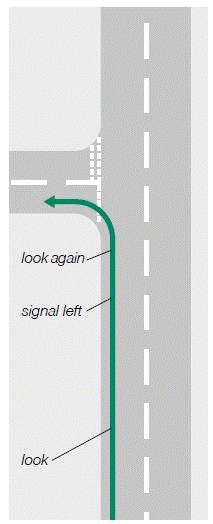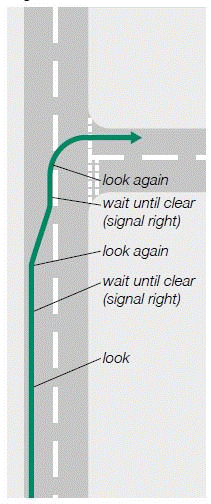At junctions, traffic may be moving in different directions. This makes such places particularly dangerous. Decide well in advance which way to go, then think of which line you wish to take. Look particularly to the rear for traffic. Before you turn, signal clearly and in good time the direction you wish to go.
Always be ready to give way to pedestrians who may step onto the road near a junction.
You cannot be seen as easily as larger vehicles and other drivers may not be looking out for cyclists - whenever it is safe to do so, give clear arm signals to let drivers behind know your intended move.
| Left-turn |
 |
When approaching a junction, look behind and ahead. Watch out for vehicles turning in front of you. Do not ride near or beside a vehicle signalling or slowing down to turn left. They may not see you. Let them pass first.
As you approach the junction, keep to the left or you may move to the middle of the lane, if it is safe to do so.
Signal left before you turn. Look out for pedestrians crossing the road. After turning, keep to the left of the road.
|
| Right-turn |
 |
Turning right is a potentially dangerous manoeuvre as you must cross the carriageway for oncoming traffic.
To turn right, signal right and then approach near the centre of the road, just to the left of the centre line. If there is a lane for right-turn, use it.
Wait until there is a safe gap in the oncoming traffic and take a final look before completing the turn. Beware of traffic coming out from the side road. Do not cut the corner during the turn. Begin to turn when you are opposite the centre of the road into which you intend to turn.
On busy roads or at night or in poor visibility, you may stop on the left side of the road and wait for a safe gap in the traffic in both directions before you make your turn. Signal before you turn. Do not wait in the middle of the road, especially at night.
In any case, or if you feel unsafe, you may dismount on the roadside and push your cycle across the road at a pedestrian crossing following the Road Crossing Code.
|
Turning into or crossing a main road
If there is a 'Stop' sign, you must stop even if there is no traffic coming. Stop behind the line, not over it.
Even where there is a 'Give way' sign, it is often better to stop and check carefully the traffic condition before you turn.
Look to the right, left and right again before you turn into a main road. Look out for other cycles as well as cars and larger vehicles coming.
If there is any traffic coming, let it pass. Do not assume that a vehicle approaching from the right and signalling left will turn left. Wait to make sure. When all traffic lanes are clear, make your turn as quickly as possible.
If you feel safer using a pedestrian crossing place to cross a road, do so but push your cycle and follow the rules and advice for pedestrians.
Traffic light junctions
You must follow all traffic signals, traffic signs and road markings at traffic light junctions. You must wait behind the 'Stop' line if the traffic light is red, or 'red and amber'. You may continue only when the green traffic light is showing and it is safe to do so (see pages 106 and 107 for more information about traffic lights).
Turning and Junctions

